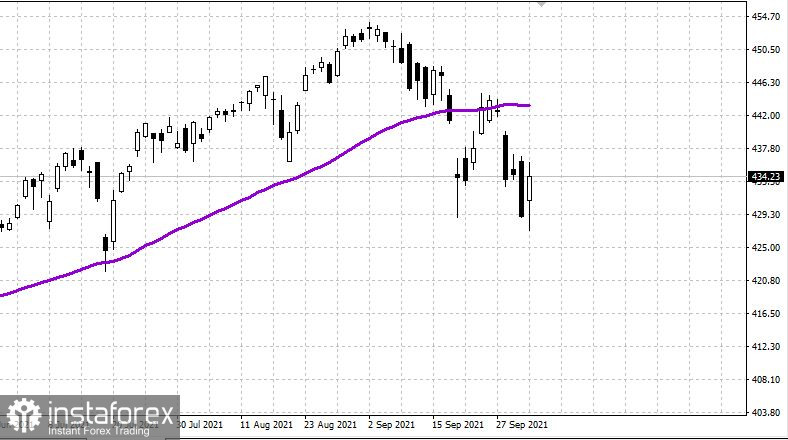
S&P500
The US market showed the first strong bounce upwards. The correction is in full swing.
After a week of continuous decline, US indices showed their first strong gains on Friday. On Friday, the Dow Jones Industrial Average rose 1.4%, NASDAQ climbed 0.8%, and the S&P500 was up by 1.2%.
Asian stock indices showed moderate gains on Monday. Thus, China's index rose by 0.7%, whereas Japan's index added 0.8%.
As for the commodity market, Brent crude was down 0.4% in the morning and is trading around $79 per barrel. This price is much more attractive to oil exporters than to consumers. Gas prices in Europe are near record highs of $1000 per thousand cubic metres. They pose a significant downside risk to the EU economy.
COVID-19 worldwide. The number of coronavirus cases decreased slightly. Yesterday, the number of new infections in the world increased by 300K. Russian officials have increased warnings that the country faces a looming fourth wave of the coronavirus pandemic. The number of new infections in Europe and Britain rose by 30K.
Inflation in the EU hit 13-year high of 3.4% in September. Average European natural gas spot prices rose by 40% in September, to $755.
S&P500 is trading at 4,357. The expected range is 4,320–4,390. Despite the strong rise on Friday, the US stock market is still in the correctional phase. By the end of the week the main US market index lost 2.5%. It is now about 5% below the highs of September 2-3. The most likely development is a wave of market gains but subsequent declines.
President Biden signed the government funding bill on Thursday, hours after congressional lawmakers rushed to pass the measure before the shutdown deadline. The bill approved by Congress would keep the government open through December 3. Fitch ratings fears the government shutdown could lead to a debt ceiling standoff, prompting a credit rating downgrade.
The ISM Manufacturing Index rose to 61.1 in September, beating the consensus expected 59.5. The major measures of activity were mixed in September. The new orders index remained unchanged at 66.7, while the prices paid index rose to 81.2 in September from 79.4 in August. The employment index rose to 50.2 from 40.9.
The Commerce Department said on Friday that the unchanged reading in construction spending followed a 0.3% gain in July.
US consumer spending increased more than expected in August. The Commerce Department said that consumer spending, which accounts for more than two-thirds of US economic activity, had rebounded 0.8%. The University of Michigan's consumer sentiment index rose more than expected to 72.8, from 70.3 in August.
USDX is trading at 94.00. The expected range is 93.70–94.30. After signing the government funding bill, the dollar fell slightly from last week's highs. This also helped the US market bounce back from lows at the week's close. Traders expect the Fed to announce the start of asset purchase programmes in November.
The USD/CAD pair is trading at 1.2615. It is likely to stay in the range of 1.2550–1.2650. The currency pair lost temporary support from the strengthening dollar. It is now down due the high oil price.
Conclusion: Traders expect the US market to rise. However, it should be noted that the growth will be volatile and corrective.
The US jobs report for September will be released this week. In September, the United States is expected to add 400,000 - 450,000 jobs.





















